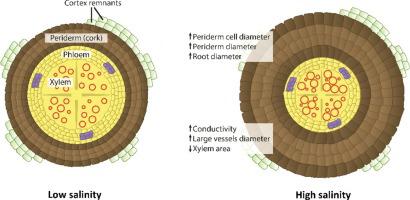当前位置:
X-MOL 学术
›
Environ. Exp. Bot.
›
论文详情
Our official English website, www.x-mol.net, welcomes your feedback! (Note: you will need to create a separate account there.)
Root structural plasticity enhances salt tolerance in mature olives
Environmental and Experimental Botany ( IF 5.7 ) Pub Date : 2020-11-01 , DOI: 10.1016/j.envexpbot.2020.104224 Junli Tan , Alon Ben-Gal , Ilana Shtein , Amnon Bustan , Arnon Dag , Ran Erel
Environmental and Experimental Botany ( IF 5.7 ) Pub Date : 2020-11-01 , DOI: 10.1016/j.envexpbot.2020.104224 Junli Tan , Alon Ben-Gal , Ilana Shtein , Amnon Bustan , Arnon Dag , Ran Erel

|
Abstract Roots are the first plant organ to encounter, sense, and respond to soil salinity. Like for many moderately salt tolerant species, roots of olive (Olea eurpaea) trees are the principal players in salt tolerance. We studied roots of mature olive trees in order to illuminate the yet vague mechanism(s) of root salt exclusion. Root structural traits were examined in olive trees grown in lysimeters and from a long-term salinity field trial. The distribution of salts was detected in root cross-sections using scanning electron microscopy combined with energy dispersive spectroscopy. Increased soil salinity caused a continuous decline in specific root length and an increase in root diameter, periderm thickness, and specific hydraulic conductivity. While periderm cell number was not modified, cell diameter increased linearly by a total of 50 % as root zone salinity increased nearly eight-fold. Strong compartmentation of Na within the periderm was found, with highest content in the outer periderm layer and lowest content in the stele. Increase in soil salinity was associated with decrease in stele area, yet, hydraulic conductivity was doubled due to higher fraction of large diameter xylem vessels. Our results indicate significant root structural plasticity, which underlies the salt resistance mechanisms. The dominant trait enabling salt tolerance of olive trees is the enlarged periderm serving as an apoplastic barrier that enhances salt compartmentation and exclusion from the vascular tissues.
中文翻译:

根结构可塑性提高成熟橄榄的耐盐性
摘要 根是第一个接触、感知和响应土壤盐分的植物器官。与许多中等耐盐物种一样,橄榄树的根部是耐盐性的主要参与者。我们研究了成熟橄榄树的根,以阐明根盐排除的模糊机制。在蒸渗仪中生长的橄榄树和长期盐度田间试验中检查了根结构特征。使用扫描电子显微镜结合能量色散光谱检测根横截面中盐的分布。土壤盐分的增加导致比根长度的持续下降和根直径、周皮厚度和比水力传导率的增加。虽然周皮细胞数没有改变,随着根区盐度增加近 8 倍,细胞直径线性增加了 50%。发现周皮内Na的强烈区室化,外周皮层含量最高,石碑含量最低。土壤盐分的增加与石碑面积的减少有关,然而,由于大直径木质部血管的比例较高,水力传导率增加了一倍。我们的结果表明显着的根结构可塑性,这是抗盐机制的基础。使橄榄树具有耐盐性的主要特征是扩大的周皮作为质外体屏障,可增强盐分分隔和从血管组织中排除。外周皮层含量最高,石碑含量最低。土壤盐分的增加与石碑面积的减少有关,然而,由于大直径木质部血管的比例较高,水力传导率增加了一倍。我们的结果表明显着的根结构可塑性,这是抗盐机制的基础。使橄榄树具有耐盐性的主要特征是扩大的周皮作为质外体屏障,可增强盐分分隔和从血管组织中排除。外周皮层含量最高,石碑含量最低。土壤盐分的增加与石碑面积的减少有关,然而,由于大直径木质部血管的比例较高,水力传导率增加了一倍。我们的结果表明显着的根结构可塑性,这是抗盐机制的基础。使橄榄树具有耐盐性的主要特征是扩大的周皮作为质外体屏障,可增强盐分分隔和从血管组织中排除。这是抗盐机制的基础。使橄榄树具有耐盐性的主要特征是扩大的周皮作为质外体屏障,可增强盐分分隔和从血管组织中排除。这是抗盐机制的基础。使橄榄树具有耐盐性的主要特征是扩大的周皮作为质外体屏障,可增强盐分分隔和从血管组织中排除。
更新日期:2020-11-01
中文翻译:

根结构可塑性提高成熟橄榄的耐盐性
摘要 根是第一个接触、感知和响应土壤盐分的植物器官。与许多中等耐盐物种一样,橄榄树的根部是耐盐性的主要参与者。我们研究了成熟橄榄树的根,以阐明根盐排除的模糊机制。在蒸渗仪中生长的橄榄树和长期盐度田间试验中检查了根结构特征。使用扫描电子显微镜结合能量色散光谱检测根横截面中盐的分布。土壤盐分的增加导致比根长度的持续下降和根直径、周皮厚度和比水力传导率的增加。虽然周皮细胞数没有改变,随着根区盐度增加近 8 倍,细胞直径线性增加了 50%。发现周皮内Na的强烈区室化,外周皮层含量最高,石碑含量最低。土壤盐分的增加与石碑面积的减少有关,然而,由于大直径木质部血管的比例较高,水力传导率增加了一倍。我们的结果表明显着的根结构可塑性,这是抗盐机制的基础。使橄榄树具有耐盐性的主要特征是扩大的周皮作为质外体屏障,可增强盐分分隔和从血管组织中排除。外周皮层含量最高,石碑含量最低。土壤盐分的增加与石碑面积的减少有关,然而,由于大直径木质部血管的比例较高,水力传导率增加了一倍。我们的结果表明显着的根结构可塑性,这是抗盐机制的基础。使橄榄树具有耐盐性的主要特征是扩大的周皮作为质外体屏障,可增强盐分分隔和从血管组织中排除。外周皮层含量最高,石碑含量最低。土壤盐分的增加与石碑面积的减少有关,然而,由于大直径木质部血管的比例较高,水力传导率增加了一倍。我们的结果表明显着的根结构可塑性,这是抗盐机制的基础。使橄榄树具有耐盐性的主要特征是扩大的周皮作为质外体屏障,可增强盐分分隔和从血管组织中排除。这是抗盐机制的基础。使橄榄树具有耐盐性的主要特征是扩大的周皮作为质外体屏障,可增强盐分分隔和从血管组织中排除。这是抗盐机制的基础。使橄榄树具有耐盐性的主要特征是扩大的周皮作为质外体屏障,可增强盐分分隔和从血管组织中排除。



























 京公网安备 11010802027423号
京公网安备 11010802027423号